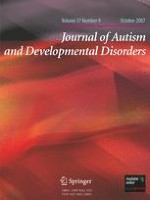01-10-2007 | Original Paper
Intellectual Ability, Self-perceived Social Competence, and Depressive Symptomatology in Children with High-functioning Autistic Spectrum Disorders
Gepubliceerd in: Journal of Autism and Developmental Disorders | Uitgave 9/2007
Log in om toegang te krijgenAbstract
Although social competence deficits in children with high-functioning autistic spectrum disorders (HFASD) are well documented, there is little research investigating self-perceptions of social limitations. This study replicated research showing a negative association between self-perceived social competence and intellectual ability and investigated associations between self-perceived social competence and depressive symptomatology. Participants were 22 children with HFASD, aged 7–13 years with intelligence quotient (IQ) scores of 82–141. Parent- (N = 18) and teacher- (N = 17) rated social competence was lower for children with HFASD compared with a normative sample. Higher age and IQ predicted lower levels of self-perceived social competence, and low self-perceived social competence predicted higher levels of depressive symptomatology. Almost a third of children rated themselves for depression; parent ratings suggested even higher levels.
